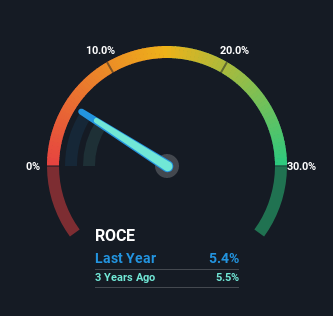- Israel
- /
- Food and Staples Retail
- /
- TASE:SAE
Capital Allocation Trends At Shufersal (TLV:SAE) Aren't Ideal
There are a few key trends to look for if we want to identify the next multi-bagger. Firstly, we'd want to identify a growing return on capital employed (ROCE) and then alongside that, an ever-increasing base of capital employed. If you see this, it typically means it's a company with a great business model and plenty of profitable reinvestment opportunities. However, after briefly looking over the numbers, we don't think Shufersal (TLV:SAE) has the makings of a multi-bagger going forward, but let's have a look at why that may be.
Return On Capital Employed (ROCE): What Is It?
If you haven't worked with ROCE before, it measures the 'return' (pre-tax profit) a company generates from capital employed in its business. The formula for this calculation on Shufersal is:
Return on Capital Employed = Earnings Before Interest and Tax (EBIT) ÷ (Total Assets - Current Liabilities)
0.054 = ₪549m ÷ (₪14b - ₪4.3b) (Based on the trailing twelve months to June 2022).
Therefore, Shufersal has an ROCE of 5.4%. Ultimately, that's a low return and it under-performs the Consumer Retailing industry average of 10%.
Check out our latest analysis for Shufersal

Historical performance is a great place to start when researching a stock so above you can see the gauge for Shufersal's ROCE against it's prior returns. If you want to delve into the historical earnings, revenue and cash flow of Shufersal, check out these free graphs here.
What The Trend Of ROCE Can Tell Us
On the surface, the trend of ROCE at Shufersal doesn't inspire confidence. Around five years ago the returns on capital were 11%, but since then they've fallen to 5.4%. On the other hand, the company has been employing more capital without a corresponding improvement in sales in the last year, which could suggest these investments are longer term plays. It's worth keeping an eye on the company's earnings from here on to see if these investments do end up contributing to the bottom line.
On a side note, Shufersal has done well to pay down its current liabilities to 29% of total assets. So we could link some of this to the decrease in ROCE. What's more, this can reduce some aspects of risk to the business because now the company's suppliers or short-term creditors are funding less of its operations. Some would claim this reduces the business' efficiency at generating ROCE since it is now funding more of the operations with its own money.
The Bottom Line
In summary, Shufersal is reinvesting funds back into the business for growth but unfortunately it looks like sales haven't increased much just yet. Unsurprisingly, the stock has only gained 14% over the last five years, which potentially indicates that investors are accounting for this going forward. Therefore, if you're looking for a multi-bagger, we'd propose looking at other options.
One more thing: We've identified 5 warning signs with Shufersal (at least 1 which is potentially serious) , and understanding them would certainly be useful.
While Shufersal may not currently earn the highest returns, we've compiled a list of companies that currently earn more than 25% return on equity. Check out this free list here.
New: Manage All Your Stock Portfolios in One Place
We've created the ultimate portfolio companion for stock investors, and it's free.
• Connect an unlimited number of Portfolios and see your total in one currency
• Be alerted to new Warning Signs or Risks via email or mobile
• Track the Fair Value of your stocks
Have feedback on this article? Concerned about the content? Get in touch with us directly. Alternatively, email editorial-team (at) simplywallst.com.
This article by Simply Wall St is general in nature. We provide commentary based on historical data and analyst forecasts only using an unbiased methodology and our articles are not intended to be financial advice. It does not constitute a recommendation to buy or sell any stock, and does not take account of your objectives, or your financial situation. We aim to bring you long-term focused analysis driven by fundamental data. Note that our analysis may not factor in the latest price-sensitive company announcements or qualitative material. Simply Wall St has no position in any stocks mentioned.
About TASE:SAE
Shufersal
Operates a chain of supermarkets under the Shufersal brand name in Israel.
Solid track record, good value and pays a dividend.
Market Insights
Community Narratives



